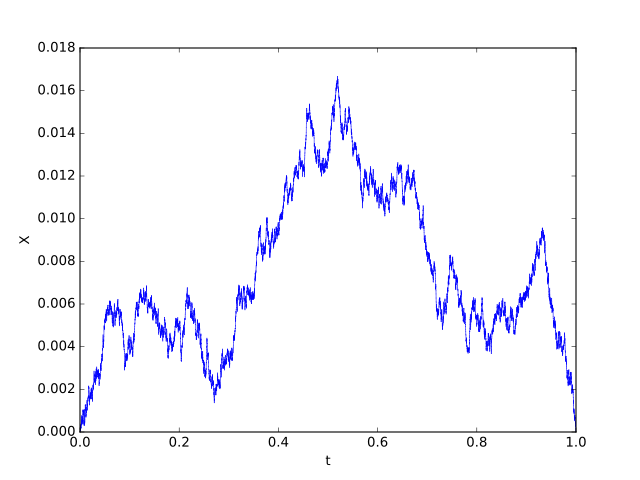Top Qs
Timeline
Chat
Perspective
Brownian excursion
Stochastic process From Wikipedia, the free encyclopedia
Remove ads
In probability theory a Brownian excursion process (BPE) is a stochastic process that is closely related to a Wiener process (or Brownian motion). Realisations of Brownian excursion processes are essentially just realizations of a Wiener process selected to satisfy certain conditions. In particular, a Brownian excursion process is a Wiener process conditioned to be positive and to take the value 0 at time 1. Alternatively, it is a Brownian bridge process conditioned to be positive. BEPs are important because, among other reasons, they naturally arise as the limit process of a number of conditional functional central limit theorems.[1]

Remove ads
Constructions
Summarize
Perspective

A Brownian excursion process, , is a Wiener process (or Brownian motion) conditioned to be positive and to take the value 0 at time 1. Alternatively, it is a Brownian bridge process conditioned to be positive. Although note that, since the probability for an unrestricted Brownian bridge to be positive is zero, the conditioning requires care.
Another representation of a Brownian excursion in terms of a Brownian motion process W (due to Paul Lévy and noted by Kiyosi Itô and Henry P. McKean, Jr.[2]) is in terms of the last time that W hits zero before time 1 and the first time that Brownian motion hits zero after time 1:[2]
where the square root is due to the square root self-similarity of Wiener process. That is, is a Wiener process for any fixed constant .

Let be the time that a Brownian bridge process achieves its minimum on [0, 1]. Vervaat (1979) shows that
This is sometimes called Vervaat's transformation.
Remove ads
Properties
Summarize
Perspective
Vervaat's representation of a Brownian excursion has several consequences for various functions of . In particular:
(this can also be derived by explicit calculations[3][4]) and
The following result holds:[5]
and the following values for the second moment and variance can be calculated by the exact form of the distribution and density:[5]
Groeneboom (1989), Lemma 4.2 gives an expression for the Laplace transform of (the density) of . A formula for a certain double transform of the distribution of this area integral is given by Louchard (1984).
Groeneboom (1983) and Pitman (1983) give decompositions of Brownian motion in terms of i.i.d Brownian excursions and the least concave majorant (or greatest convex minorant) of .
For an introduction to Itô's general theory of Brownian excursions and the Itô Poisson process of excursions, see Revuz and Yor (1994), chapter XII.
Remove ads
Connections and applications
Summarize
Perspective
With probability 1, a Wiener process is continuous, which means the set on which it is non-zero is an open subset of the real line, thus it is the union of countably many Brownian excursions.
The Brownian excursion area
arises in connection with the enumeration of connected graphs, many other problems in combinatorial theory; see e.g.[6][7][8][9][10] and the limit distribution of the Betti numbers of certain varieties in cohomology theory.[11] Takacs (1991a) shows that has density
where are the zeros of the Airy function and is the confluent hypergeometric function. Janson and Louchard (2007) show that
and
They also give higher-order expansions in both cases.
Janson (2007) gives moments of and many other area functionals. In particular,
Brownian excursions also arise in connection with queuing problems,[12] railway traffic,[13][14] and the heights of random rooted binary trees.[15]
Remove ads
Related processes
- Brownian bridge
- Brownian meander
- reflected Brownian motion
- skew Brownian motion
Notes
References
Wikiwand - on
Seamless Wikipedia browsing. On steroids.
Remove ads























